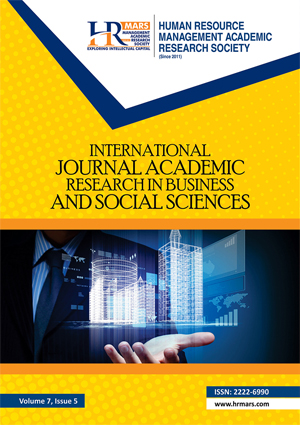
ISSN: 2222-6990
Open access
The rapid digitalization of the tourism industry has transformed how destinations attract and retain travelers, particularly among Gen Z consumers, who are the most digitally engaged demographic. This study explores the impact of digital branding on destination loyalty, focusing on Gen Z travelers in China. A conceptual model is developed to examine how digital brand engagement, functional value, emotional value, and sustainability perception influence destination loyalty, with perceived destination image acting as a mediating variable. A survey of 350 Gen Z travelers in China was conducted, and structural equation modeling (SEM) was used to analyze the data. The findings indicate that digital brand engagement is a critical determinant of destination loyalty, with emotional value and sustainability perception playing significant roles. Moreover, perceived destination image mediates the relationship between digital branding efforts and destination loyalty, reinforcing the importance of online interactions and brand authenticity in shaping travel behaviors. This study contributes to the growing literature on digital tourism marketing and provides practical insights for destination marketers aiming to enhance engagement and long-term visitor retention through strategic digital branding.
Bagozzi, R. P., & Yi, Y. (1988). On the evaluation of structural equation models. Journal of the Academy of Marketing Science, 16(1), 74-94. https://doi.org/10.1007/BF02723327
Buhalis, D., & Volchek, K. (2021). Bridging marketing and smart tourism through digital branding. Journal of Tourism Futures, 7(3), 243-259. https://doi.org/10.1108/JTF-06-2021-0156
Chen, C. F., & Tsai, D. (2007). How destination image and evaluative factors affect behavioral intentions. Tourism Management, 28(4), 1115-1122. https://doi.org/10.1016/j.tourman.2006.07.007
Chi, C. G.-Q., & Qu, H. (2008). Examining the structural relationships of destination image, tourist satisfaction, and destination loyalty: An integrated approach. Tourism Management, 29(4), 624-636. https://doi.org/10.1016/j.tourman.2007.06.007
Chon, K. S. (1992). The role of destination image in tourism: A review and discussion. Tourist Review, 47(2), 2-9. https://doi.org/10.1108/eb058040
Churchill, G. A. (1979). A paradigm for developing better measures of marketing constructs. Journal of Marketing Research, 16(1), 64-73. https://doi.org/10.2307/3150876
Cronin, J. J., Brady, M. K., & Hult, G. T. M. (2000). Assessing the effects of quality, value, and customer satisfaction on consumer behavioral intentions in service environments. Journal of Retailing, 76(2), 193-218. https://doi.org/10.1016/S0022-4359(00)00028-2
Duman, T., & Mattila, A. S. (2005). The role of affective factors on perceived cruise vacation value. Tourism Management, 26(3), 311-323. https://doi.org/10.1016/j.tourman.2003.11.014
Espinoza, F. (1999). Assessing the cross-cultural applicability of a service quality measure: A comparative study between Quebec and Peru. International Journal of Service Industry Management, 10(5), 449-468. https://doi.org/10.1108/09564239910288987
Fornell, C., & Larcker, D. F. (1981). Evaluating structural equation models with unobservable variables and measurement error. Journal of Marketing Research, 18(1), 39-50. https://doi.org/10.2307/3151312
Fromm, J., & Read, A. (2021). Marketing to Gen Z: The rules for reaching this vast and very different generation of influencers. AMACOM.
Hair, J. F., Black, W. C., Babin, B. J., & Anderson, R. E. (2006). Multivariate data analysis (6th ed.). Pearson Education International.
Hankinson, G. (2004). The brand images of tourism destinations: A study of the saliency of organic images. Journal of Product & Brand Management, 13(1), 6-14. https://doi.org/10.1108/10610420410523803
Holbrook, M. B. (1999). Consumer value: A framework for analysis and research. Routledge.
Huang, C. Y., Lin, C. Y., Su, H. J., & Tung, C. M. (2015). Examining the moderating role of travel motivation on travel intention and destination image. Journal of Hospitality & Tourism Research, 39(4), 528-553. https://doi.org/10.1177/1096348013491593
Kim, S., Kim, J., & Park, J. (2023). The influence of sustainability messaging on Gen Z’s travel intentions: A digital engagement perspective. Journal of Sustainable Tourism, 31(2), 295-312. https://doi.org/10.1080/09669582.2022.2133456
Kladou, S., Kavaratzis, M., Rigopoulou, I., & Salonika, E. (2017). The role of brand elements in destination branding. Journal of Destination Marketing & Management, 6(4), 426-435. https://doi.org/10.1016/j.jdmm.2017.06.011
Kline, R. B. (2006). Principles and practice of structural equation modeling (2nd ed.). Guilford Press.
Liu, Y., Tang, J., & Yu, H. (2022). Digital branding in tourism: A study on the impact of influencer marketing on destination image and tourist behavior. Tourism Review, 78(1), 77-93. https://doi.org/10.1108/TR-06-2021-0251
Neter, J., Wasserman, W., & Kutner, M. H. (1985). Applied linear statistical models (2nd ed.). Richard D. Irwin, Inc.
Nunnally, J. C. (1978). Psychometric theory (2nd ed.). McGraw-Hill.
Ooi, C. S. (2004). Branding cities, changing societies: The social context of destination branding. Journal of Place Branding, 1(1), 50-58. https://doi.org/10.1057/palgrave.pb.5990003
Pike, S., & Ryan, C. (2004). Destination positioning analysis through a comparison of cognitive, affective, and conative perceptions. Journal of Travel Research, 42(4), 333-342. https://doi.org/10.1177/0047287504263029
Podsakoff, P. M., MacKenzie, S. B., Lee, J. Y., & Podsakoff, N. P. (2003). Common method biases in behavioral research: A critical review of the literature and recommended remedies. Journal of Applied Psychology, 88(5), 879-903. https://doi.org/10.1037/0021-9010.88.5.879
Podsakoff, P. M., & Organ, D. W. (1986). Self-reports in organizational research: Problems and prospects. Journal of Management, 12(4), 531-544. https://doi.org/10.1177/014920638601200408
Qu, H., Kim, L. H., & Im, H. H. (2011). A model of destination branding: Integrating the concepts of branding and destination image. Tourism Management, 32(3), 465-476. https://doi.org/10.1016/j.tourman.2010.03.014
Sánchez, J., Callarisa, L., Rodríguez, R., & Moliner, M. (2006). Perceived value of the purchase of a tourism product. Tourism Management, 27(3), 394-409. https://doi.org/10.1016/j.tourman.2004.11.007
Stepchenkova, S., & Li, X. R. (2014). Destination image: Do tourists really care? Journal of Travel Research, 53(1), 81-93. https://doi.org/10.1177/0047287513496474
Wang, X. (2022). How Gen Z travelers shape tourism marketing: Digital strategies for destination branding. Journal of Travel & Tourism Marketing, 39(2), 156-178. https://doi.org/10.1080/10548408.2022.2034834
Yuliang, C., & Lasi, M. A. (2025). Exploring the Impact of Digital Branding on Destination Loyalty: A Study on Gen Z Travelers in China. International Journal of Academic Research in Business and Social Sciences, 15(4), 1143–1155.
Copyright: © 2025 The Author(s)
Published by HRMARS (www.hrmars.com)
This article is published under the Creative Commons Attribution (CC BY 4.0) license. Anyone may reproduce, distribute, translate and create derivative works of this article (for both commercial and non-commercial purposes), subject to full attribution to the original publication and authors. The full terms of this license may be seen at: http://creativecommons.org/licences/by/4.0/legalcode